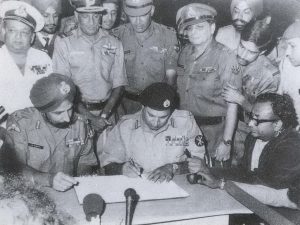Blog Archives
Eid Festival in Bangladesh
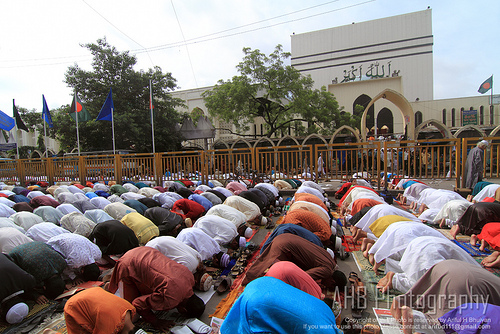
Bangladesh is a Muslim majority country. Therefore, the two Eids, Eid-ul-fitr and Eid-ul-adha are two main festivals of the country. The happiness and joy of the Eid is spread to all the citizens of Bangladesh. Everyone, regardless of their religion enjoy the Eid festivals. Bangladeshi’s enjoy three to four days of public holidays during each Eid festivals.
Eid-ul-Fitr:
This is the largest religious festival for Muslims. Eid-ul-Fitr comes on the first day of the Islamic month of Shawwal, after the month of Ramadan. The whole month of Ramadan Muslims fasts and does special prayers a lot for the satisfaction of Allah. Eid-ul-Fitr marks the end of Ramadan.
Eid-ul-Adha:
This is the second most important religious festival of Muslims in Bangladesh. People also call it “Qurbani Eid” in here. This is the 10th day of jill-hajj, the 12th month of Islamic calendar. This festival is to commemorate the willingness of Prophet Ibrahim (a) to sacrifice his son as an act of submission to Allah’s command. Bangladeshi Muslims sacrifice their domestic animals like cows and goats during the Eid-ul-adha.

The main difference between Eid-ul-Fitr and Eid-ul-Adha are the Ramadan and the Qurbani or sacrifice of domestic animals. Otherwise the celebrations are similar in many ways.
Preparation of Eid: The Joy of Eid starts long before with shopping. People buy new dresses for themselves, their families, friends and fore families. Punjabi is the most favorite dress during Eid for men. For women, its shari and salwar kamiz. Eid gift is very traditional in the country as well.
Specially in the Eid-ul-Adha there are Animal Huts at the renowned open places (Like fields etc) of the country, people buy animals from there for Qurbani.
Sending Eid Cards: This is a very old tradition of Bangladesh. People sends Eid cards before the Eid to their friends and relatives. Children are usually more enthusiast to present Eid greeting cards to their friends and cousins. Before Eid, temporary Eid cards and sticker shops are seen everywhere on the streets, children buy cards in cheap form there. Now a day’s peoples are using social network or online technology to send virtual EID greeting cards.
Going home: Peoples who usually come to live in the major cities for their profession goes to their home town or village to celebrate the festivals with their families, relatives and friends. No matter how long the distance is, going home is a must during the Eid for most. Every village home become full during this period. People gathers everywhere in the Streets and Bazars of the home town, they meet with their family, friends, relatives and neighbors, they may not have met for months or even years. They greet each other and embrace.
Specially from the Dhaka most people goes home during Eid. People have to book their bus, train or launch ticket long before the journey. All the transports become overloaded during then. The fare of the transport tend to rise in many cases in spite of government’s monitoring and restriction. Everyone is desperate to go back home. Despite all the troubles to arrange tickets and to go to home, festival starts immediately after reaching there. People forget the troubles when they meet their families and soulmates after some long.
Finding the new moon: Finding the new moon is another excitement during Eid-ul-Fitr. It brings suspense to everyone, because the Eid will happen next day if the moon is seen on the evening before. Everyone looks to the sky or eagerly waits to hear the news that the moon is seen anywhere in the country. The joys knows no bound if the moon is seen that evening. This night is called “Chand Raat.” If the moon is not seen in the ‘chand raat’, Eid will be held one day later.

Coloring hands with mehendi: Girls and kids color their hands with ‘mehendi’ (hena leaves) before the Eid day. Girls gather to their senior family members or relatives, who can beautifully color their hands with mehendi. Kids become crazy to when the coloring is done. They compete with each other on deepness of the color.

Eid Day: In the Eid Day many people goes to graves of their relatives, specially parents to pray for them. Some people go to graves after the Eid prayer. Before the prayer people give a charity known as fitra. Many people distribute Zakat (donations) before the Eid prayer.
In the morning people take a bath, wear new dresses and go to Eid prayer. They gather at Eidgahs (Special places for Eid prayer) to pray. There are many Eidgahs in each cities, but most people try to gather to tha main Eidgah of the city to be part of the biggest gathering in the town and pray to the almighty.
People hug each other and exchange greetings after the prayer. This trend continues during the whole period of Eid, when they meet friends and relatives first time. The juniors do salam (greetings) to their elders and elders bless them with ‘Eidi’ (new notes of money). Collecting Eidi is a very interesting part of the Eid celebration.
During the Eid-ul-Adha, Just after the prayer, wealthy people sacrifices domestic animals. This is called Qurbani (sacrifice). They distribute the meat among the poor , their relatives and neighbors. The half of the day, people remains very busy processing and distributing meats. The less wealthy people also take part in the festivity by visiting wealthy people’s house and help them in Qurbani.
Special Foods of EID: This is Sunnah of taking sweet food before the Eid prayer. ‘Semai’ is a common food of Eid. Women prepare delicious noodles, pasta, chotpoti, Halim, biriyani, kebab, polao rice, roasts, and curry on the Eid day. Meat curry and khichuri is very famous during Eid-ul-Adha. Many people eat special parata with meat curry of the sacrificed animals. They also prepare many other sweets or special foods along with those common ones as per their ability.

Eid Celebration: In the afternoon everyone with their all the family members go to their relatives or neighbor’s house wearing new cloths. Everyone remains ready to welcome the guest. They serve the prepared foods to the guests. People celebrate the day by visiting the parks, meeting their friends and walking on the streets. Many people go to restaurant with their friends and family in the evening. Children remains very keen to go to the amusement parks in the city. Lots of movie lovers go to cinema halls or theaters to watch the newly released movies. People also watch Eid special serials on TV at home. All local TV channels air special programs, funny serials, and short films for several days during the occasion.
The Eid celebration lasts from three days to a week. After the Eid people return to their profession and live the life as usual and starts waiting for the next Eid.
(All the photos used in this post were collected from internet.)
A Guide to Explore the Beautiful Bangladesh
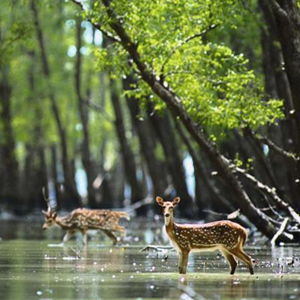
Bangladesh is a South Asian nation of luxuriant greenery and numerous waterways. It’s Padma, Meghna and Jamuna Rivers make fruitful alluvial fields. On the southern coast, the Sundarbans, a tremendous mangrove forest, is home to the Royal Bengal Tiger.
Here we listed some important things you must do or see in the Beautiful Bangladesh.

Historical Places:
If you visit Bangladesh, there are a lot of things to do. You can explore the historical places of Bangladesh. Bangladesh is enriched with natural beauties and historical establishments. It has its two thousand years history. Below are the list of most famous Historical places of Bangladesh.
- Ahsan Manzil – Dhaka
- Central Shaheed Minar at Dhaka
- Curzon Hall, University of Dhaka
- The tomb of Bibi Pari, located in the center of Lalbagh Fort, Dhaka
- Shah Paran Darga Sharif, Sylhet
- Hazrat Shahjalal Mazar Sharif, Sylhet
- The Gour Gobinda Fort, Sylhet
- Shat Gumbad/Gambuj Mosque, Bagerhat, Khulna
- Mainamati, famous Buddhist archaeological site, Comilla
- Mahasthangarh, Bogra
- Paharpur Buddhist temple, Naogaon
- Kantajew Temple, Dinajpur
- Liberation War Museum, Dhaka
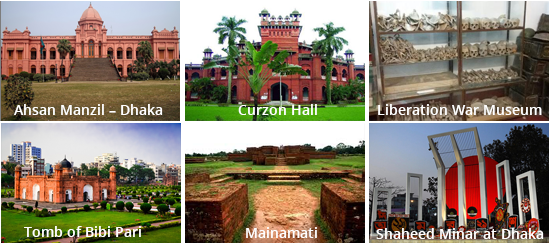
Most Attractive Places in Bangladesh:
Bangladesh is a natural beauty. Along with the nature, there are lots of temples, national memorial monuments are the main attraction of Bangladesh. Explore the list below:
- Baitul Mukarram Mosque
- Dhakeshwari Temple
- National Martyrs’ Memorial monument “Jatiyo Sriti Shoudho”.
- The National Parliament House
- National Museum
- Sundarban, Khulna
- The longest beach in the world, Cox’s Bazar
- Coral Island, St. Martin’s Island
- Boga Lake, Bandarban
- Nilgiri, Bandarban
- Nilachal, Bandarban
- Jaflong, Sylhet City
- Madhabkunda Waterfall, Sylhet
- Kuakata, Potuakhali
- Lowacherra National Park (Sreemangal), Sylhet
- Bichnakandi, Sylhet
- Ratargul Swamp Forest, Sylhet
- Sajek Valley, Khagrachari
- Inani Beach, Cox’s Bazar
- Kaptai Lake, Chittagong
- Alutila Cave, Khagrachari
- Sangu River, Bandarban
- Parjatan Hanging Bridge, Rangamati
- Patenga Beach, Chittagong City
- Shuvolong Waterfalls, Rangamati
- Himchori, Cox’s Bazar
- Karnaphuli River, Chittagong City
- Neval Beach, Chittagong City
- Foy’s Lake, Chittagong City
- Richhang Falls, Khagrachari
- Dulahazra Safari Park, Chittagong City
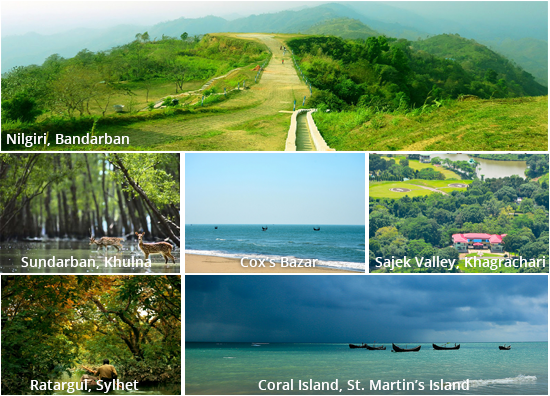
Fair & Festival:
Fair & Festival is a common Bangladeshi specialty, held throughout the year with great zeal and zest. If you are in Bangladesh, you must see the most common religious, traditional, national and tribal festivals all over the year. Let’s check the most common festivals:
- Eid-ul-Fitr
- Eid-ul-Azha
- Durga Puja
- Holi festival
- Buddha Purnima
- Christmas
- Independence Day (on 26th March)
- Victory Day (on 16th December)
- International Mother Language Day (on 21st February)
- National Mourning Day (15th August)
- Pahela Baishakh
- Dubla Rash Mela
- Shakrain Festival
- Lalon Mela
- Fair of Ashwin Sankranti
- Fair of Ghoshbila
- Kothin Chibor Dan Utsab
- Langalbandh Fair
- Shib Chaturdashi Fair
- Gurpukur Fair
- Golakandail Fair
- Fair of Adinath
- Rabindra & Nazrul Jayanti
- Amor Ekushey Boi Mela (Book Fair)
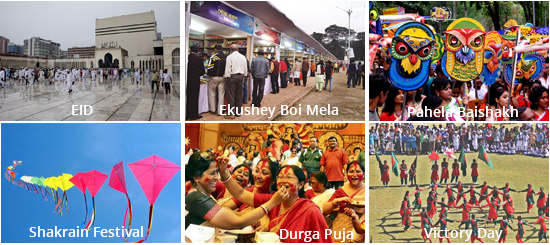
Food Habits and Varieties of Bangladesh:
Each nation has its own tradition of nourishment’s. Bangladesh has likewise the same. In the feeling of nourishment practice, Bangladesh is influenced by the territorial varieties of her history. Let’s check the Food Habits and Varieties of Bangladesh:
- Breakfast:
- Paratha
- Naan
- Bean curry
- Vegetables
- Omelet

- Lunch & Dinner:
- Rice
- Beef curry
- Fish curry
- Chicken curry
- Shrimp curry
- Lentil soup
- Red leaf curry
- Mix vegetables
- Bhorta (mashed vegetables or dried fish with spices)
- Grilled Chicken
- Biriyani
- Boorhani
- Khichuri
- Shish Kebab

- Desert:
- Semai
- Faluda
- Yoghurt
- Sweets etc.

- Beverages:
- Prepared tea (Most popular)
- Lassi
- Sugarcane juice
- Lime and date juice
- Green coconut water
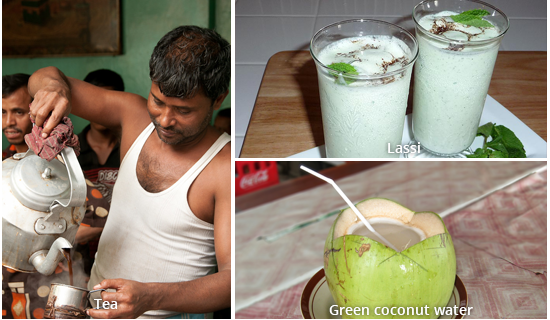
- Snacks:
- Singara
- Fuchka
- Somosa
- Chotpoti
- Pitha
- Jilapi
- Pyaju
- Halim
- Chop
- Chow mein

Traditional Attire of Bangladesh:
Traditional Attire of Bangladesh is variegated in its nature and also unique as compared to other neighboring countries. Bangladeshi woman wear sharee (National wear), Salwar kameez, Frock etc. Mens most common wearing’s are Punjabi, lungi, shirt, t-shirts, jeans. Girls use nose pierce after getting married and also use mehedi, churi, teep in different festivals.
Souvenirs:
You can take souvenirs like local snacks or traditional crafts from Bangladesh by strolling around shopping centers, take look at stores besides streets. Let’s find unique Bangladeshi souvenirs:
- Food items:
- Tea bags
- Chanachur
- Jhal muri
- Lassi can
- Mango juice bottle
- Mango bar packet
- Mango candy
- Aachar (Bangladeshi pickle)
- Spice mix
- Biscuits
- Traditional Items:
- Nokshi katha
- Gamcha (thin cotton towel)
- Pakha (Traditional fan)
- Jute Bag
- Coaster with Nokshi katha design
- Small rickshaw toy
- Accessory box
- Pottery
- Mug cup with Bangla letter.
- Bracelet
- Soap
- Mobile bag
- Bag
- Pen case
- Book mark rickshaw design
- T-shirt with rickshaw design
- Scarf
By now, you might have a good idea about Bangladesh. If you are interested to know more, please check the Handbook by Bangladesh Parjatan Corporation. This will help you explore the beautiful Bangladesh with great images and excellent guidelines.
Bangladesh in a Nutshell
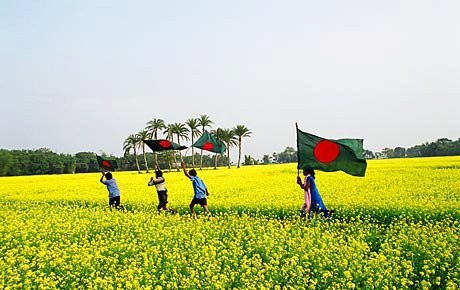
Bangladesh, official name “The People’s Republic of Bangladesh” is situated in southern Asia, on the Indian subcontinent. The area of country is 147,570 square kilometers (56,977 square miles). The administration of Bangladesh is divided into seven major regions called divisions (Dhaka, Chittagong, Khulna, Barisal, Rajshai, Sylhet and Rangpur. The divisions of Bangladesh are divided into 64 districts, or zila. Districts are further subdivided into 493 upazila or sub-districts. Dhaka the capital city of Bangladesh is located in the central part of the country.
Bengali is the national language is spoken by 95% of the population, however English is widely understood. About 90% of the population is Islamic, the rest of the population comprised of Hindu, Buddhist, and Christian minorities.
The people of Bangladesh are very simple, friendly and hospitable. Sound communal harmony with the different religions in Bangladesh has ensured a very congenial atmosphere. More than 75% of the population live in rural areas. However, Urbanization has been rapid in the last few years.
Bangladesh has an agrarian economy. Yet it dominates the economy accommodating major rural labour force.
At a Glance:
| NAME(OFFICIAL): | The People’s Republic of Bangladesh |
| LOCATION: | lies between 20° 34′ and 26° 38′ North Latitude and 88° 01′ and 92° 41′ East Longitude |
| BOUNDARY: | On three sides- East, North and West-India. South-East Myanmar. South-Bay of Bengal |
| AREA: | 147,570 sq km |
| POPULATION: | 150 million(Approximately) |
| ADMINISTRATIVE UNITS: | Country is divided into seven Administrative Divisions. These are Dhaka, Chittagong, Khulna, Rajshahi, Barisal, Sylhet and Rangpur. Each Division is divided into districts |
| TOTAL DISTRICTS: | 64 |
| CAPITAL: | Dhaka |
| OTHER MAJOR CITIES: | Chittagong, Khulna, Rajshahi, Sylhet & Barisal |
| GOVERNMENT: | Parliamentary form of government. The President is Head of the state, while the government is headed by the Prime Minister |
| PLACES OF TOURIST INTEREST: | Dhaka, Chittagong, Cox’s Bazar, Kaptai, Rangamati, Khagrachari, Bandarban, Kuakata, Bogra, Khulna, the Sundarbans, Sylhet, Rajshahi, Dinajpur and Comilla |
| LANGUAGE: | Bangla-Official Language, English-Second language and widely spoken |
| LABOUR FORCE: | 54 million Male: 40 million Female: 14 million (Ref: BES-2011) |
| SECTORAL DISTRIBUTION OF LABOUR FORCE: | Agriculture: 48.4 percent Industry: 24.3 percent Others: 27.3percent (Ref: BES-2011) |
| RELIGION: | 4 major religions: Islam, Hinduism, Christianity & Buddhism |
| PRINCIPAL EXPORTS: | Agricultural products, Ready-made garments, Knitwear, Jute and Jute goods, Shrimps, Leather and Leather goods, Pharmaceuticals, Tea, Handicrafts, Ceramic, Light Engineering Products, etc. |
| PRINCIPAL IMPORTS: | Chemicals, Cement, Petroleum & Lubricants, Capital Machinery, Machinery parts, Tinned and Bagged Milk powder, Edible oil, Automobiles, electronics etc. |
| PRINCIPAL INDUSTRIES: | Garments, Textile, Jute, Sugar, Leather, Chemical, Pharma, Fertilizer, Shrimp Processing, Cement, Paper, Engineering etc |
| PRINCIPAL MINERAL: | Natural gas,oil, Coal, white clay, glass sand etc. |
| AIRPORTS: | Dhaka, Chittagong, Sylhet, Jessore, Rajshahi, Saidpur, Barisal and Cox’s Bazar |
Nawab Shaista Khan Period
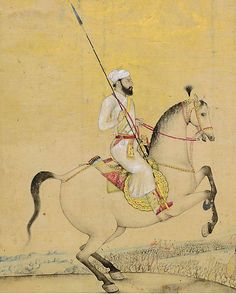
Shaista Khan was a general and a subahdar in the Mughal army. He served Bangla as the Mughal governor from 1664 to 1688. During the period of Shaista Khan the city of Dhaka and Mughal power attained its greatest heights in the Bangla province. The largest expansion of the city took place under the governor. Dhaka city then stretched for 12 miles in length and 8 miles in breadth and is believed to have had a population of nearly a million people. Babubazar Mosque, Chawk Mosque, Choto Katra, Saat Mosque and various majestic monuments and palaces across the province were built during nawab shaista khan period that represented the finest in Indo-Sarcenic and Mughal architecture. He also built tombs of Bibi Pari, Bibi Champa and Dara Begum.
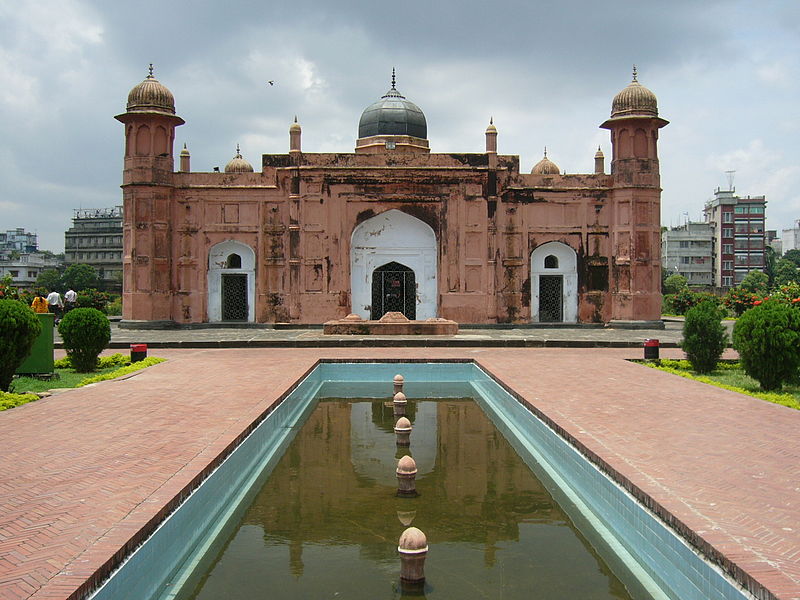
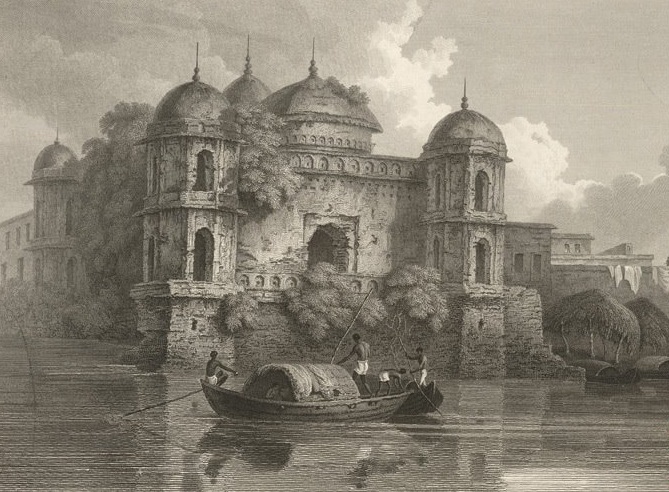
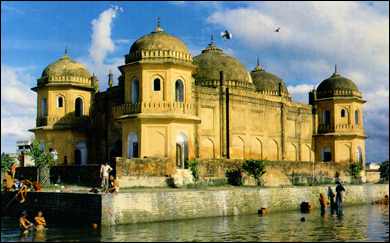
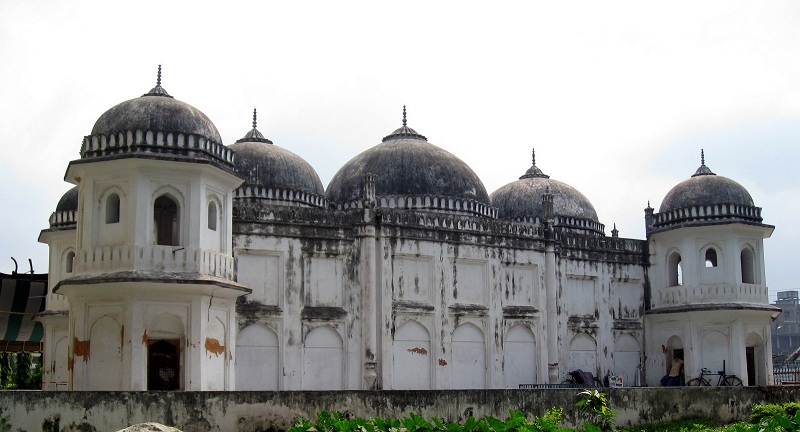
Pritilata Waddedar

Pritilata Waddedar (May 5, 1911 – September 23, 1932) was a Bengali anti-British revolutionary nationalist. She was the first Indian subcontinent woman revolutionary to fight the British. She was very meritorious student. After completing her education (First division in matriculation from Dr. Khastagir Government Girls’ School of Chittagong and securing Fifth place in Intermediate examination from Eden College, Dhaka under Dhaka Board) she attended Bethune College in Calcutta (now Kolkata). She graduated in Philosophy with distinction.
After a brief stint as a school teacher, Pritilata joined a revolutionary group headed by Surya Sen. In 1932 She led a 15 man team of revolutionaries in an attack on the Pahartali European Club, which had a sign board was written “Dogs and Indians not allowed”. The revolutionaries torched the club and were caught by the British police later. In order to avoid arrest, Pritilata consumed cyanide and committed suicide. Thus ending her short endeavor in fighting for freedom of her country. Some say that she committed suicide voluntarily to convey the message that women can, and have to sacrifice lives for securing the freedom our country from British Colonial Rule.

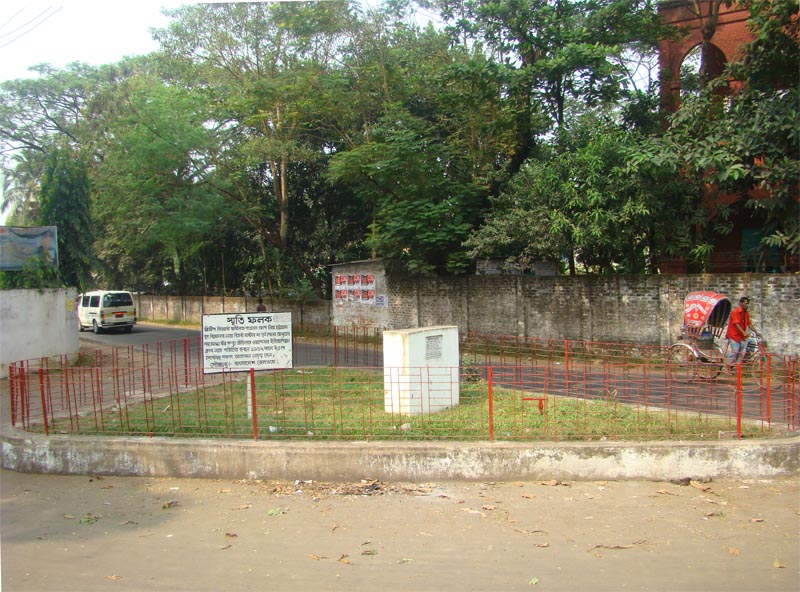
Khudiram Bose
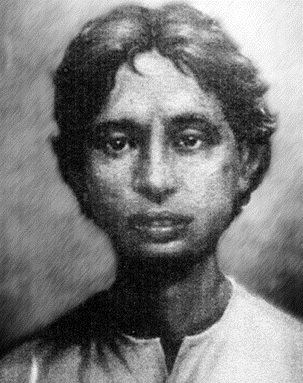
Khudiram Bose (December 3, 1889 – August 11, 1908) was a Bengali revolutionary and one of the youngest revolutionaries early in the Indian independence movement.
He was born on 3rd December 1889 Bahuvaini in Medinipur district, West Bengal (India).His father Trailokyanath Bose and mother Lakshmipriya Devi.
Khudiram Bose was inspired by the cry of Vande Mataram which became very famous after the novel Anandamath by Bankim Chandra Chattopadhyay. He started taking active part in Swadeshi movement and worked actively in the protest movement against the partition of Bengal in 1905 by Lord Curzon, the Governor General of India. Khudiram Bose joined a secret extremist outfit called Yugantar which formed by Aurobindo Ghosh, Barin Ghosh and Raja Subodh Mallik together.
30th April, 1908 in Muzzafarpur, Bihar Khudiram Bose and Prafulla Chaki planned to assassinate the Chief Presidency Magistrate Kingsford. The magistrate was known for his blatant judgments against the freedom fighters. They waited for Kingsford’s carriage to come in front of the gate of European Club and blew up a carriage but which was not carrying Kingsford. As a result of this unfortunate incident two British ladies – Mrs. Kennedy and her daughter were killed.
Khudiram was arrested on 1 st May 1908, Prafulla evaded arrest by shooting himself Khudiram was tried and was sentenced to be hanged to death. On 11 th August 1908. Like a true lover of his motherland and a genuine martyr he welcomed his death.
Not only Khudiram himself became immortal, but he also inspired others by his sacrifice of life for the motheland, to become immortal. In course of time, thousands of young men and women followed in his footsteps.
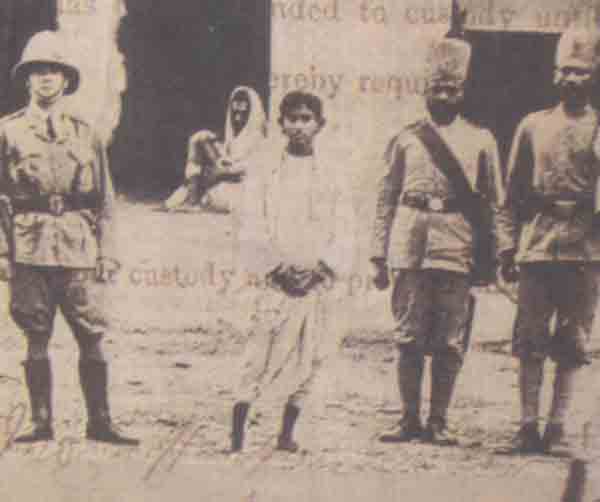
1952 Language Movement
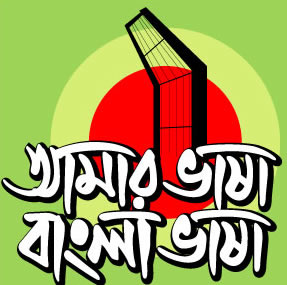
The Bengali Language Movement, additionally referred to as the Language Movement (Bengali: ভাষা আন্দোলন, Bhasa Andolon), was a political movement in former East Bengal (today Bangladesh) advocating the popularity of the Bengali language as an official language of the then-Dominion of Pakistan so as to permit its use in government affairs, the continuation of its use as a medium of education, its use in media, currency and stamps, and to keep up its writing within the Bengali script.
1969 Uprising in East Pakistan (Now Bangladesh)
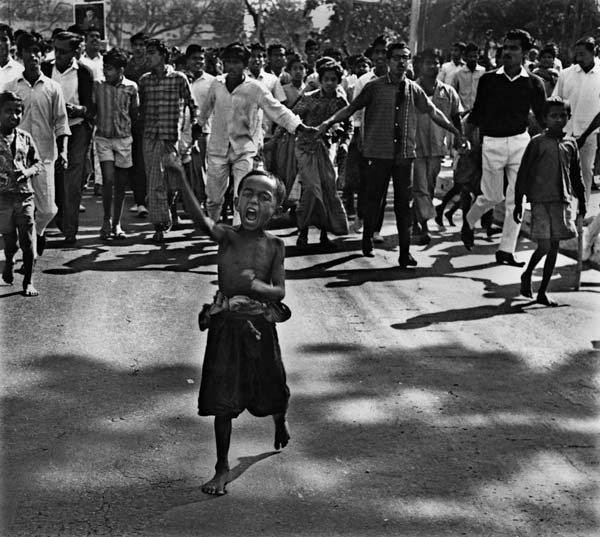
1969 uprising (ঊনসত্তরের গণঅভ্যুত্থান) was a democratic political movement in East Pakistan (now Bangladesh ) that came about in 1969.The uprising consisted of a series of mass demonstrations and noncontinuous conflicts between government defense force and therefore the demonstrators. Though the unrest began in 1966 with the six purpose movement of Awami League, it got momentum at the start of 1969 and culminated within the resignation of Marshall Ayub Khan, the primary military ruler of Pakistan. The uprising additionally led to the withdrawal of Agartala Conspiracy Case and final decision of Sheikh Mujibur Rahman and his colleagues from the case.
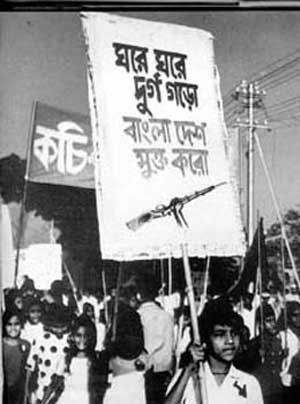 The revolutionary rising of the working masses shook the military regime of Ayub Khan, who was replaced by General Yahiya Khan in March 1969. The situation was ripe for a socialist revolution led by the workers. The workers, peasants, urban poor, students, layers of the urban and rural middle categories, and youth showed their determination, courage and power and continued their struggle to overthrow capitalism and feudalism. The concepts of socialism spread like wildfire. The big general strike and mass demonstrations paralyzed the state equipment for over a month, in the East and West. Through this movement the Bengali nations 1st articulated their intentions of identity as an individual nation that was essentially mirrored within the 1st Constitution of Bangladesh by reflective philosophical system, socialism and marked by Bengali nationalism. This can be important to mention, this constitutional statement had been modified through the military rule when 1975 which was closely associated with the coup makers and their intentions. Political instability and economic difficulties marked Pakistan’s history from its formation. In1956, a constitution was finally adopted, describing the country as an ‘Islamic republic within the Commonwealth’. The political musical chairs continued till the imposition of martial law in1958 by General Ayub Khan. This was maintained till 1962, once Khan declared himself president (and field marshal) – he stood down in March 1969. Martial law was once more imposed between 1969, once General Yahiya Khan took over, and 1971. Prolonged military rule any alienated the Bengali population. Not only did the gulf between wealthy and poor reach unprecedented levels, aggravating classtensions, however the inequality between West and East Pakistan also reached new heights.
The revolutionary rising of the working masses shook the military regime of Ayub Khan, who was replaced by General Yahiya Khan in March 1969. The situation was ripe for a socialist revolution led by the workers. The workers, peasants, urban poor, students, layers of the urban and rural middle categories, and youth showed their determination, courage and power and continued their struggle to overthrow capitalism and feudalism. The concepts of socialism spread like wildfire. The big general strike and mass demonstrations paralyzed the state equipment for over a month, in the East and West. Through this movement the Bengali nations 1st articulated their intentions of identity as an individual nation that was essentially mirrored within the 1st Constitution of Bangladesh by reflective philosophical system, socialism and marked by Bengali nationalism. This can be important to mention, this constitutional statement had been modified through the military rule when 1975 which was closely associated with the coup makers and their intentions. Political instability and economic difficulties marked Pakistan’s history from its formation. In1956, a constitution was finally adopted, describing the country as an ‘Islamic republic within the Commonwealth’. The political musical chairs continued till the imposition of martial law in1958 by General Ayub Khan. This was maintained till 1962, once Khan declared himself president (and field marshal) – he stood down in March 1969. Martial law was once more imposed between 1969, once General Yahiya Khan took over, and 1971. Prolonged military rule any alienated the Bengali population. Not only did the gulf between wealthy and poor reach unprecedented levels, aggravating classtensions, however the inequality between West and East Pakistan also reached new heights.
Source: Wikipedia, Academi.edu
7th March 1971

The Speech of 7th March 1971 was a speech given by the Father of the Nation Bangabandhu Sheikh Mujibur Rahman, architect of independent Bangladesh at the Ramna Race Course Maidan (currently Suhrawardy Udyan) in Dhaka to a gathering of over two million people. The speech delivered encouraged the Bengalis to start nine-month long bloody struggle for freedom. ‘Ebarer Sangram Amader Muktir Sangram, Ebarer Sangram Swadhinatar Sangram’ (“this struggle is for our freedom, this struggle is for our independence”), is what the architect of the nation’s independence famously pronounced.
Speech of Bangabandhu on 7th March 1971
Sheikh Mujibur Rahman mentioned a further four-point condition to consider:
- Immediate withdrawal of all military personnel to their barracks.
- Immediate lifting of martial law.
- An inquiry into the loss of life.
- Immediate transfer the power to the elected representative of the people before the assembly meeting March 25.
Bangabandhu also revealed program of several directives that was the extent of the civil disobedience movement for the freedom of the nation. Those were:
- He asks the people not to pay taxes and asks the government.
- 2. The secretariat, government and semi-government offices, High court and other courts throughout East Bangla will observe Hartals. Appropriate exemptions will be announced from time to time.
- Radio, television and newspapers shall give complete versions of Bangabandhu’s statement and shall not suppress news about the people’s movement, otherwise Bangali worker in these establishment shall cooperate.
- Railway and ports may function, but railway and port workers will not cooperate if railway or ports are used for mobilizing of forces for the purpose of repression against the people.
- Only local and inter-district telephone communication shall function.
- All educational institution shall remain closed.
- Banks shall not effect remittances to the Western wing either through the State Bank or otherwise.
- Black flags shall be hoisted on all buildings every day.
- Hartal is withdrawn in all other spheres but complete hartal may be declared at any moment depending on the situation.
- A ‘Sangram Parishad’ should be organized in each union, mohallah, thana, sub-division – under the leadership of the local Awami League units.
He exhorted the people to turn every house in East Bangla into a fortress.
Finally, raising his fist Bangabandhu cried out at the top of his voice: “Our struggle this time is a struggle for freedom, our struggle this time is a struggle for independence. Joy Bangla.”
Bangladesh Liberation War, 1971

The Bangladesh Liberation War (Bangla: মুক্তিযুদ্ধ Muktijuddho) was a revolutionary independence war in South Asia during 1971 which established the republic of Bangladesh. The nine months durations of war engaged East Pakistan (later joined by India) against West Pakistan. It witnessed large-scale cruelty, barbarity and atrocities, the departure of 10 million refugees and the translocation of 30 million people.
On 26 March 1971 the war broke out, when the Pakistani Army launched a military operation called Operation Searchlight on 25 March black night. That night the Pakistan army spilled out to the streets destroying everything on sight and killing Bengali civilians, students, intelligentsia, armed personnel, who were demanding that the Pakistani military junta accept the results of the 1970 first democratic elections of Pakistan, which were clearly majority won by Sheikh Mujibur Rahman, the head of the largest political party of Pakistan, the Awami League, or to allow separation between East and West Pakistan. Bangladeshi politicians and army officer Major Ziaur Rahman announced the declaration of Bangladesh’s independence on behalf of Sheikh Mujibur Rahman in response to Operation Searchlight. Bangladeshi military, paramilitary and civilians formed the Mukti Bahini (Bangla: মুক্তি বাহিনী “Liberation Army”) and engaged in guerrilla warfare against Pakistani raider forces. The Pakistan Army, in collusion with religious extremist militias (the Razakars, Al-Badr and Al-Shams), engaged in the systematic genocide and atrocities of Bengali civilians, particularly nationalists, intellectuals, youth and religious minorities. Bangladesh government-in-exile was set up in the city of Calcutta (now Kolkata) in the Indian State of West Bengal.
Pakistan launched pre-emptive air strikes on northern India which excited India to enter into the war on 3rd December 1971. Overwhelmed by two war fronts, Pakistani defences soon collapsed. On 16 December, the Allied Forces of Bangladesh and India defeated Pakistan in the east. The subsequent surrender resulted in the largest number of prisoners-of-war since World War II.
Bangladesh Liberation War in Images:
Source: Wikipedia



